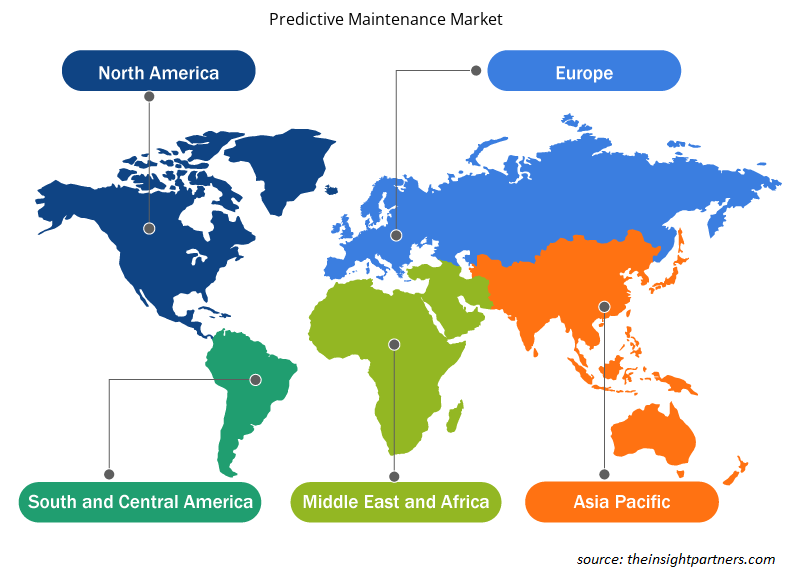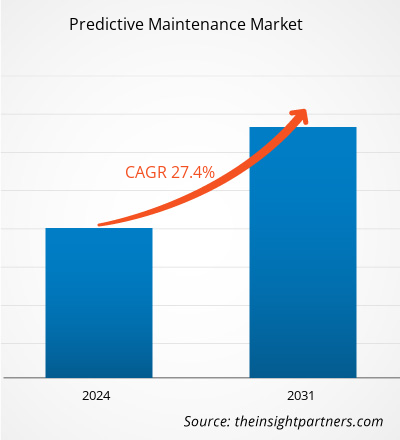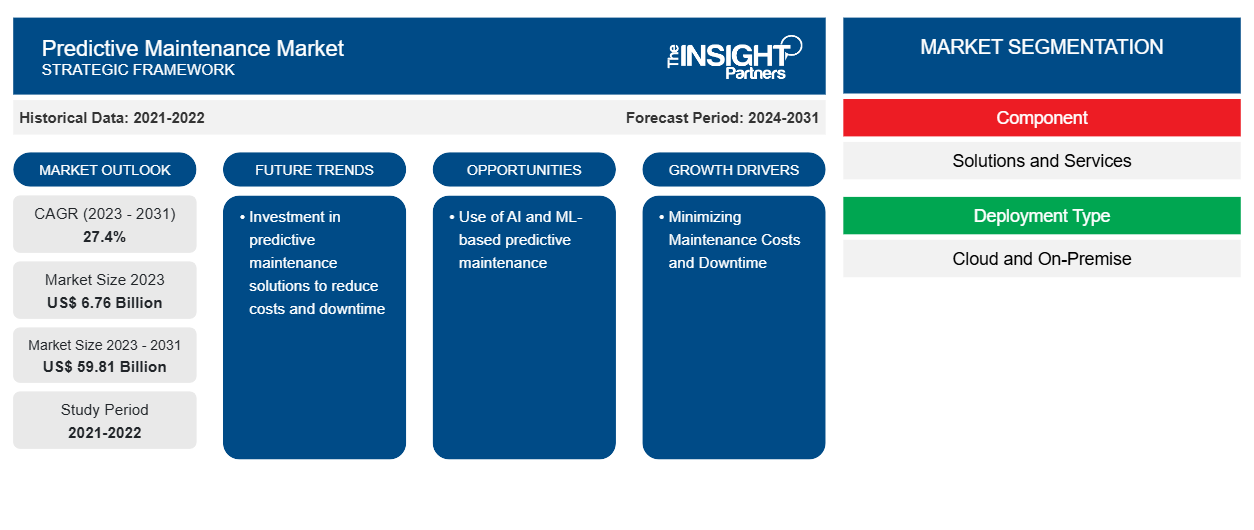预测性维护市场规模预计将从 2023 年的 67.6 亿美元增至 2031 年的 598.1 亿美元。预计 2023-2031 年期间的复合年增长率为 27.4%。投资预测性维护解决方案以降低成本和停机时间可能仍是市场的主要趋势。
预测性维护市场分析
近几十年来,降低日益昂贵的能源成本和向可持续未来转变的需求日益高涨,使得能源审计变得非常重要。由于能源支出是工业界关注的一大问题,因此企业不断检查能源消耗,并努力将其降至最低。
预测性维护市场概况
预测性维护通过融合物联网传感器、人工智能和数据科学来提高设备性能。它需要采用基于云的技术来监控和估计基于资产状态的维护需求,以及识别可能导致意外故障的异常情况。因此,制造商可以通过预测设备维护需求来节省成本并增加正常运行时间,从而获得巨大收益。实时监控工业资产的核心方法是基于条件的监控。先进的 IIoT 传感器记录复杂的机器健康数据,例如振动、声学、温度和 RPM 等。然后对收集的数据进行评估,以识别资产性能的任何差异或传统设备难以检测到的问题。
定制此报告以满足您的需求
您可以免费定制任何报告,包括本报告的部分内容、国家级分析、Excel 数据包,以及为初创企业和大学提供优惠和折扣
-
获取此报告的关键市场趋势。这个免费样品将包括数据分析,从市场趋势到估计和预测。
预测性维护市场驱动因素和机遇
最大限度地减少维护成本和停机时间以利于市场
现在,组织越来越希望减少维护费用、设备故障和停机时间。预测性维护是解决这些困难的绝佳方法。预测性维护系统使用数据分析和机器学习来识别设备中可能出现的缺陷,从而实现主动维护干预。提前预测设备故障可让公司在计划停机期间安排维修,从而减少运营中断并最大限度地延长设备正常运行时间。
使用基于人工智能和机器学习的预测性维护
基于人工智能的预测性维护在制造业中有着广泛的应用。它采用强大的机器学习算法来评估生产过程中收集的大量数据,为实现卓越制造提供关键见解。此外,机器学习算法利用大量历史数据来模拟各种情况,并预测何时会出现什么问题。先进的人工智能算法可以识别机器的典型数据行为,并将其用作实时检测和警告变化的基准。
预测性维护市场报告细分分析
有助于得出预测性维护市场分析的关键部分是组件、部署类型、技术和行业。
- 根据组件,市场按解决方案和服务进行细分。解决方案部门在 2023 年占据了相当大的市场份额。
- 根据部署类型,市场分为云和本地。云部分在 2023 年占据了最大的市场份额。
- 根据技术,市场细分为振动监测、电气测试、油分析、超声波泄漏检测器、冲击脉冲、红外线等。振动监测部分在 2023 年占据了最大的市场份额。
- 根据行业,市场分为制造业、能源和公用事业、航空航天和国防、运输和物流、石油和天然气等。制造业在 2023 年占据了最大的市场份额。
预测性维护市场份额(按地区)分析
预测性维护市场报告的地理范围主要分为五个地区:北美、亚太、欧洲、中东和非洲、南美和中美。
2023 年,北美占据了市场主导地位。机器学习 (ML)、声学监测、人工智能 (AI) 和物联网 (IoT) 等现代技术的使用,以及客户渠道的扩展和对资产维护和运营费用日益增长的担忧,都促进了增长。此外,消费电子产品和 M2M 应用中采用物联网连接设备、汽车行业对联网汽车的需求不断增长以及对创新消费电子产品日益增长的需求正在推动市场扩张。
预测性维护市场区域洞察
Insight Partners 的分析师已详细解释了预测期内影响预测性维护市场的区域趋势和因素。本节还讨论了北美、欧洲、亚太地区、中东和非洲以及南美和中美洲的预测性维护市场细分和地理位置。

- 获取预测性维护市场的区域特定数据
预测性维护市场报告范围
| 报告属性 | 细节 |
|---|---|
| 2023 年的市场规模 | 67.6亿美元 |
| 2031 年市场规模 | 598.1亿美元 |
| 全球复合年增长率(2023 - 2031) | 27.4% |
| 史料 | 2021-2022 |
| 预测期 | 2024-2031 |
| 涵盖的领域 |
按组件
|
| 覆盖地区和国家 |
北美
|
| 市场领导者和主要公司简介 |
|
市场参与者密度:了解其对商业动态的影响
预测性维护市场正在快速增长,这得益于最终用户需求的不断增长,而这些需求又源于消费者偏好的不断变化、技术进步以及对产品优势的认识不断提高等因素。随着需求的增加,企业正在扩大其产品范围,进行创新以满足消费者的需求,并利用新兴趋势,从而进一步推动市场增长。
市场参与者密度是指在特定市场或行业内运营的企业或公司的分布情况。它表明相对于给定市场空间的规模或总市场价值,有多少竞争对手(市场参与者)存在于该市场空间中。
预测性维护市场的主要运营公司有:
- 通用电气公司日立有限公司
- IBM 公司
- 微软公司
- PTC公司
- SAS 研究所
- 施耐德电气
免责声明:上面列出的公司没有按照任何特定顺序排列。

- 获取预测性维护市场顶级关键参与者概览
预测性维护市场新闻和最新发展
预测性维护市场通过收集一手和二手研究后的定性和定量数据进行评估,其中包括重要的公司出版物、协会数据和数据库。预测性维护市场的一些发展如下所列:
- 埃森哲公司收购了亚马逊网络服务 (AWS) 高级合作伙伴 Nextira,该公司使用 AWS 服务为客户提供预测分析、云原生创新和沉浸式体验。这些 AWS 服务和解决方案使 Accenture Cloud First 能够提高其技术技能,同时还为客户提供全面的云功能。Nextira 提供基于云的服务,利用尖端的人工智能、机器学习、工程专业知识和数据分析来帮助用户构建、设计、启动和优化高性能计算环境。(来源:埃森哲公司,新闻稿,2023 年 6 月)
- GE Vernova 的天然气发电业务宣布已签署一份多年期协议,将在科威特艾哈迈迪建设一座 876 兆瓦 (MW) 的发电厂。这份多年期协议包括提供零件、维修、现场服务、高级预测性维护和数字解决方案。(来源:GE Vernova,新闻稿,2023 年 12 月)
预测性维护市场报告范围和交付成果
“预测性维护市场规模和预测(2021-2031)”报告对以下领域进行了详细的市场分析:
- 预测性维护市场规模以及范围涵盖的所有关键细分市场的全球、区域和国家层面的预测
- 预测性维护市场趋势以及市场动态,如驱动因素、限制因素和关键机遇
- 详细的 PEST/波特五力分析和 SWOT 分析
- 预测性维护市场分析涵盖主要市场趋势、全球和区域框架、主要参与者、法规和最新市场发展
- 行业格局和竞争分析,涵盖市场集中度、热图分析、知名参与者以及超导市场的最新发展
- 详细的公司简介
- 历史分析(2 年)、基准年、预测(7 年)及复合年增长率
- PEST和SWOT分析
- 市场规模、价值/数量 - 全球、区域、国家
- 行业和竞争格局
- Excel 数据集
近期报告
客户评价
购买理由
- 明智的决策
- 了解市场动态
- 竞争分析
- 客户洞察
- 市场预测
- 风险规避
- 战略规划
- 投资论证
- 识别新兴市场
- 优化营销策略
- 提升运营效率
- 顺应监管趋势























 获取免费样品 - 预测性维护市场
获取免费样品 - 预测性维护市场